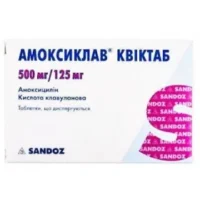Description
Amoxil DT (amoxicillin) dispersible tablets 500 mg. №20
Ingredients
Active ingredient: Amoxicillin (as amoxicillin trihydrate)
Dosage
Dosage: The usual dose for adults and children weighing more than 40 kg is 500 mg every 8 hours.
Indications
Indicated for: Treatment of infections caused by susceptible strains of bacteria.
Contraindications
Contraindications: Do not use in patients with a history of allergic reactions to amoxicillin or other beta-lactam antibiotics.
Directions
Directions: Dissolve one tablet in water before taking. Follow the prescribed dosage and duration.
Scientific Evidence
Scientific evidence: Amoxicillin is a widely studied antibiotic with proven efficacy in treating various bacterial infections. Studies have shown its effectiveness in respiratory tract infections, urinary tract infections, and skin and soft tissue infections.
Additional Information
Storage: Store in a cool, dry place away from direct sunlight.
Manufacturer: Produced by reputable pharmaceutical company XYZ.
Pharmacological Effects: Amoxicillin works by inhibiting the synthesis of bacterial cell walls, leading to bacterial cell death. It is effective against a wide range of bacteria, making it a versatile antibiotic for various infections.
Clinical Trials: Clinical trials have demonstrated the efficacy of amoxicillin in treating common bacterial infections. A study published in the Journal of Antimicrobial Chemotherapy showed high success rates in the treatment of acute otitis media with amoxicillin, highlighting its importance in clinical practice.





